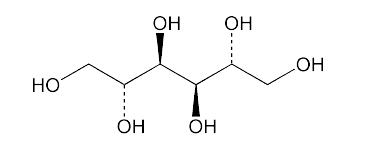Enhanced TDS
Identification & Functionality
- Chemical Name
- Industry
- Molecular formula
- C₆H₁₄O₆
- Technologies
- Product Families
- Chemical Structure

Applications & Uses
Properties
- Physical Form
- Soluble In
- Typical Properties
Value Units Test Method / Conditions Mannitol (dried basis) 97.0 - 102.0 % - Molecular Weight 182.17 - -
Regulatory & Compliance
- Certifications & Compliance
- Chemical Inventories
- FDA Disclaimer
These statements have not been evaluated by the Food and Drug Administration. This product is not intended to diagnose, treat, cure, or prevent any disease.
- USP Reference Standards
- USP Mannitol RS
Technical Details & Test Data
- Assay Procedure
ASSAY
• PROCEDURE
Mobile phase: Degassed water
System suitability solution A: 25.0 mg/mL each of sorbitol and USP Mannitol RS
System suitability solution B: 1.0 mg/mL each of maltitol and isomalt
Standard solution A: 50.0 mg/mL of USP Mannitol RS
Standard solution B: Dilute 2.0 mL of the Sample solution with water to 100.0 mL.
Standard solution C: Dilute 0.5 mL of Standard solution B with water to 20.0 mL.
Sample solution: 50.0 mg/mL of MannitolChromatographic system (See Chromatography á621ñ, System Suitability.)
Mode: LC
Detector: Refractive index
Column: 7.8-mm × 30-cm; packing L19 Temperatures
Detector: 40° (maintain at a constant temperature)
Column: 85 ± 2°
Flow rate: 0.5 mL/min Injection volume: 20 µL
Run time: NLT 1.5 times the retention time of the mannitol peak.
[NOTE—The retention time for mannitol is about 20 min.]
Packaging & Availability
- Labelling Information
The label states, where applicable, the maximum concentration of bacterial endotoxins. The label states, where applicable, that the substance is suitable for use in the manufacture of parenteral dosage forms.
Storage & Handling
- Storage Information
Preserve in well-closed containers.
